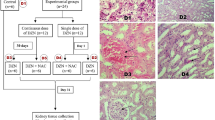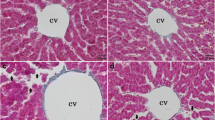Abstract
Dimethoate (DM) is an organophosphate insecticide widely used in agriculture and industry and has toxic effects on non-target organisms especially mammalian. However, we still know little about DM-induced kidney injury and its alleviation by natural antioxidants. In the present study, selenium (Se), vitamin E, DM, Se+DM, vitamin E+DM, Se+vitamin E+DM were given to adult rats for 4 weeks. Plasma creatinine and uric acid, kidney MDA, PC, H2O2 and AOPP levels were higher, while Na+-K+-ATPase and LDH values were lower in the DM group than those of controls. A smear without ladder formation on agarose gel was shown in the DM group, indicating random DNA degradation and DM-induced genotoxicity. A decrease in kidney GSH, NPSH and plasma urea levels and an increase in GPx, SOD and catalase activities were observed in the DM group when compared to those of controls. Plasma cystatin C levels increased, indicating a decrease in glomerular filtration rate. When Se or vitamin E was added through diet, the biochemical parameters cited above were partially restored in Se+DM and vitamin E+DM than DM group. The joint effect of Se and vitamin E was more powerful against DM-induced oxidative stress and kidney dysfunction. The changes in biochemical parameters were substantiated by histological data. In conclusion, our results indicated a possible mechanism of DM-induced nephrotoxicity, where renal genotoxicity was noted, membrane-bound ATPases and plasma biomarkers were disturbed. Se and vitamin E ameliorated the toxic effects of this pesticide in renal tissue suggesting their role as potential antioxidants.



Similar content being viewed by others
References
Betrosian A, Balla M, Kafiri G, Kofinas G, Makri R, Kakouri A (1995) Multiple systems organ failure from organophosphate poisoning. J Toxicol Clin Toxicol 33:257–260
WHO/IPCS (1996) Principles and methods for assessing direct immunotoxicity associated with exposure to chemicals, Environmental Health Criteria vol. 180. WHO, Geneva, pp 110–112
Darko G, Akoto O (2008) Dietary intake of organophosphorus pesticide residues through vegetables from Kumasi, Ghana. Food Chem Toxicol 46:3703–3706
Boon PE, Van der Voet H, Van Raaij MTM, Van Klaveren JD (2008) Cumulative risk assessment of the exposure to organophosphorus and carbamate insecticides in the Dutch diet. Food Chem Toxicol 46:3090–3098
Bakasa I, Ben Oujji N, Moczko E, Istamboulie G, Piletsky S, Piletska E, Ait-Addi E, Ait-Ichou I, Noguera T, Rouillon R (2013) Computational and experimental investigation of molecular imprinted polymers for selective extraction of dimethoate and its metabolite omethoate from olive oil. J Chromatogr A 1274:13–18
Araoud M, Gazzah N, Douki W, Najjar MF, Kenani A (2012) Rapid multi-residue method for the determination of pesticide residues in human serum. Afr J Biotechnol 11:12579–12585
Yamada H, Hishida A, Kumagai H et al (1992) Effects of age renal diseases and diabetes mellitus on the renal size reduction accompanied by the decrease of renal function. Nippon-Jinzo-Gakkai-Shi 34:1071–1075
Eddleston M, Eyer P, Worek F, Mohamed F, Senarathna L, Von Meyer L, Juszczak E, Hittarage A, Azhar S, Dissanayake W, Sheriff MH, Szinicz L, Dawson AH, Buckley NA (2005) Differences between organophosphorus insecticides in human self-poisoning: a prospective cohort study. Lancet 366:1452–1459
De-Bleecker J, Van-Den-Neucker K, Colradyn F (1993) Intermediate syndrome in organophosphorus poisoning: a prospective study. Crit Care Med 21:1706–1711
Dongren Y, Taol L, Fengsheng H (1999) Electrophysiological studies in rats of acute dimethoate poisoning. Toxicol Lett 107:1–3
Institoris L, Siroki O, Desi I, Undeger U (1999) Immunotoxicological examination of repeated dose combined exposure by dimethoate and two heavy metals in rats. Hum Exp Toxicol 18:88–94
Kamath V, Rajini PS (2007) Altered glucose homeostasis and oxidative impairment in pancreas of rats subjected to dimethoate intoxication. Toxicology 231:137–146
Kayan M, Nazıroğlu M, Barak C (2010) Effects of vitamin C and E combination on trace element levels in blood of smokers and nonsmokers radiology X-ray technicians. Biol Trace Elem Res 136:140–148
Nazıroğlu M, Yoldaş N, Uzgur EN, Kayan M (2013) Role of contrast media on oxidative stress, Ca2+ signaling and apoptosis in kidney. J Membr Biol 246:91–100
Bal R, Nazıroğlu M, Türk G, Yılmaz Ö, Kuloğlu T, Etem E, Baydas G (2012) Imidacloprid induces morphological and DNA damage through oxidative toxicity on the reproductive organs of developing male rats. Cell Biochem Funct 30:492–499
Shirpoor A, Salami S, Khadem-Ansari MH, Ilkhanizadeh B, Pakdel FG, Khademvatani K (2009) Cardioprotective effect of vitamin E: rescues of diabetes-induced cardiac malfunction, oxidative stress, and apoptosis in rat. J Diabetes Complicat 23:310–316
Nazıroğlu M (2009) Role of selenium on calcium signaling and oxidative stress- induced molecular pathways in epilepsy. Neurochem Res 34:2181–2191
Papp LV, Lu J, Holmgren A, Khanna KK (2007) From selenium to selenoproteins: synthesis, identity, and their role in human health. Antioxid Redox Signal 9:775–806
Rayman MP (2000) The importance of selenium to human health. Lancet 356:233–241
Nazıroğlu M, Karaoğlu A, Aksoy AO (2004) Selenium and high dose vitamin E administration protects cisplatin-induced oxidative damage to renal, liver and lens tissues in rats. Toxicology 195:221–230
Cemek M, Buyukben A, Buyukokuroğlu ME, Aymelek F, Tur L (2010) Protective roles of vitamin E (a-tocopherol), selenium and vitamin E plus selenium in organophosphate toxicity in vivo: a comparative study. Pest Biochem Physiol 96:113–118
Council of European Communities (1986) Council instructions about the protection of living animals used in scientific investigations. Off J Eur Communities L358:1–18, JO 86/609/CEE
Ben Amara I, Soudani N, Hakim A, Bouaziz H, Troudi A, Zeghal KM, Zeghal N (2012) Dimethoate-induced oxidative damage in erythrocytes of female adult rats: possible protective effect of vitamin E and selenium supplemented to diet. Toxicol Ind Health 28:222–237
Lowry OH, Rosebrugh NJ, Farr AL, Randall RJ (1951) Protein measurement with the Folin phenol reagent. J Biol Chem 193:265–275
Draper HH, Hadley M (1990) Malondialdehyde determination as index of lipid peroxidation. Methods Enzymol 186:421–431
Ou P, Wolff SP (1996) A discontinuous method for catalase determination at ‘near physiological’ concentrations of H2O2 and its application to the study of H2O2 fluxes within cells. J Biochem Biophys Methods 31:59–67
Kayali R, Cakatay U, Akcay T, Altug T (2006) Effect of alpha-lipoic acid supplementation on markers of protein oxidation in post-mitotic tissues of ageing rat. Cell Biochem Funct 24:79–85
Reznick AZ, Packer L (1994) Oxidative damage to proteins: spectrophotometric method for carbonyl assay. Method Enzymol 233:357–363
Kawamoto EM, Munhoz CD, Glezer I, Bahia VS, Caramelli P, Nitrini R, Gorjao R, Curi R, Scavone C, Marcourakis T (2005) Oxidative state in platelets and erythrocytes in aging and Alzheimer’s disease. Neurobiol Aging 26:857–864
Kanno S, Shouji A, Hirata R, Asou K, Ishikawa M (2004) Effects of naringin on cytosine arabinoside (Ara-C)-induced cytotoxicity and apoptosis in P388 cells. Life Sci 75:353–365
Ellman GL, Courtney KD, Andres V, Featherstone R (1961) A new and rapid colorimetric determination of acetyl cholinesterase activity. Biochem Pharmacol 7:88–95
Jollow DJ, Mitchell JR, Zampaglione N, Gillete JR (1974) Bromobenzene induced liver necrosis: protective role of glutathione and evidence for 3,4-bromobenzeneoxide as the hepatotoxic intermediate. Pharmacology 11:151–169
Aebi H (1984) Catalase in vitro. Method Enzymol 105:121–126
Beauchamp C, Fridovich I (1971) Superoxide dismutase: improved assays and an assay applicable to acryl amide gels. Anal Biochem 44:276–287
Flohe L, Gunzler WA (1984) Assays of glutathione peroxidase. Method Enzymol 105:114–121
Roos JF, Doust J, Tett SE, Kirkpatrick CM (2007) Diagnostic accuracy of cystatin C compared to serum creatinine for the estimation of renal dysfunction in adults and children—a meta-analysis. Clin Biochem 40:383–391
Donadio C, Lucchesi A, Tramonti G, Bianchi C (1997) Creatinine clearance predicted from body cell mass is a good indicator of renal function. Kidney Int Suppl 63:166–168
Levander OA, Morris VC (1971) Effects of vitamin E and selenium on Rubidium-86 uptake by rat liver slices. J Nutr 101:1013–1022
Astiz M, De Catalfo GEH, De Alaniz MJT, Marra CA (2009) Involvement of lipids in dimethoate-induced inhibition of testosterone biosynthesis in rat interstitial cells. Lipids 44:703–718
Novais SC, De Coen W, Amorim MJ (2012) Gene expression responses linked to reproduction effect concentrations (EC 10,20,50,90) of dimethoate, atrazine and carbendazim, in Enchytraeus albidus. PLoS One 7:e36068
Burton GW, Le Page Y, Gabe EJ, Ingold KU (1980) Antioxidant activity of vitamin E and related phenols. Importance of stereoelectronic factors. J Am Chem Soc 102:7791–7792
McPherson A (1994) Selenium vitamin E and biological oxidation. In: Cole DJ, Garnsworthy PJ (eds) Recent advances in animal nutrition. Butterworth and Heinemann’s, Oxford, pp 3–30
Li X, Hill KE, Burk RF, May JM (2001) Selenium spares ascorbate and α-tocopherol in cultured liver cell lines under oxidant stress. FEBS Lett 508:489–492
Diplock AT, Lucy JA (1973) The biochemical modes of action of vitamin E and selenium: a hypothesis. FEBS Lett 29:205–210
Sodhi S, Sharma A, Brar APS, Brar RS (2008) Effect of α-tocopherol and selenium on antioxidant status, lipid peroxidation and hepatopathy induced by malathion in chicks. Pest Biochem Physiol 90:82–86
Acknowledgments
This work was supported by the DGRST grants (Appui à la Recherche Universitaire de Base ARUB 99/UR/08-73), Tunisia. The authors are indebted to Miss Dalenda Kchaou for her assistance in histolological techniques and to Mr. Bejaoui Hafedh, teacher of English at Sfax Faculty of Science, who helped proofread and edited this paper.
Conflict of Interest
The authors declare that there are no conflicts of interest.
Author information
Authors and Affiliations
Corresponding author
Additional information
Aida Karray and Ahmed Hakim contributed equally to this work.
Rights and permissions
About this article
Cite this article
Ben Amara, I., Karray, A., Hakim, A. et al. Dimethoate Induces Kidney Dysfunction, Disrupts Membrane-Bound ATPases and Confers Cytotoxicity Through DNA Damage. Protective Effects of Vitamin E and Selenium. Biol Trace Elem Res 156, 230–242 (2013). https://doi.org/10.1007/s12011-013-9835-0
Received:
Accepted:
Published:
Issue Date:
DOI: https://doi.org/10.1007/s12011-013-9835-0




